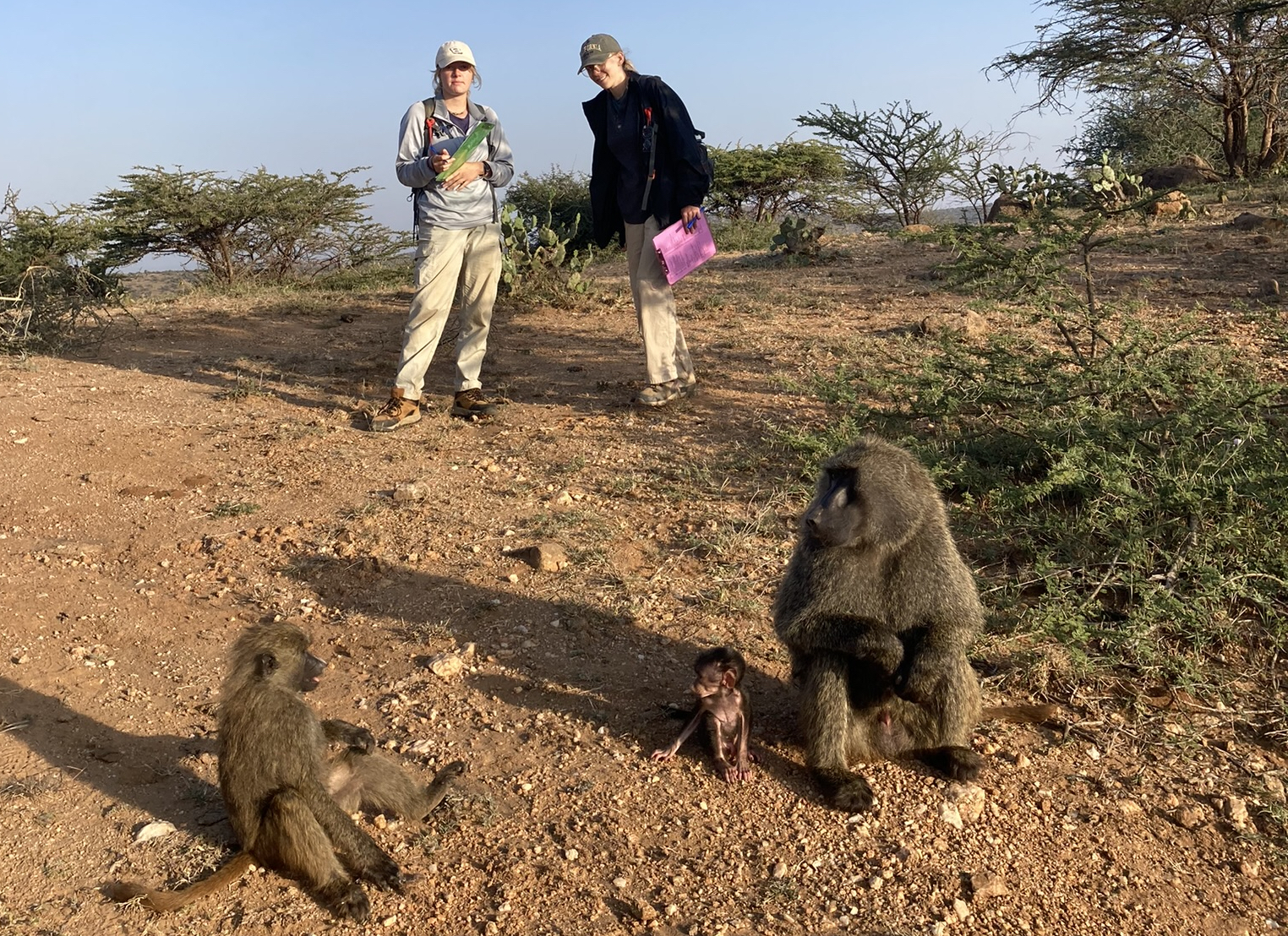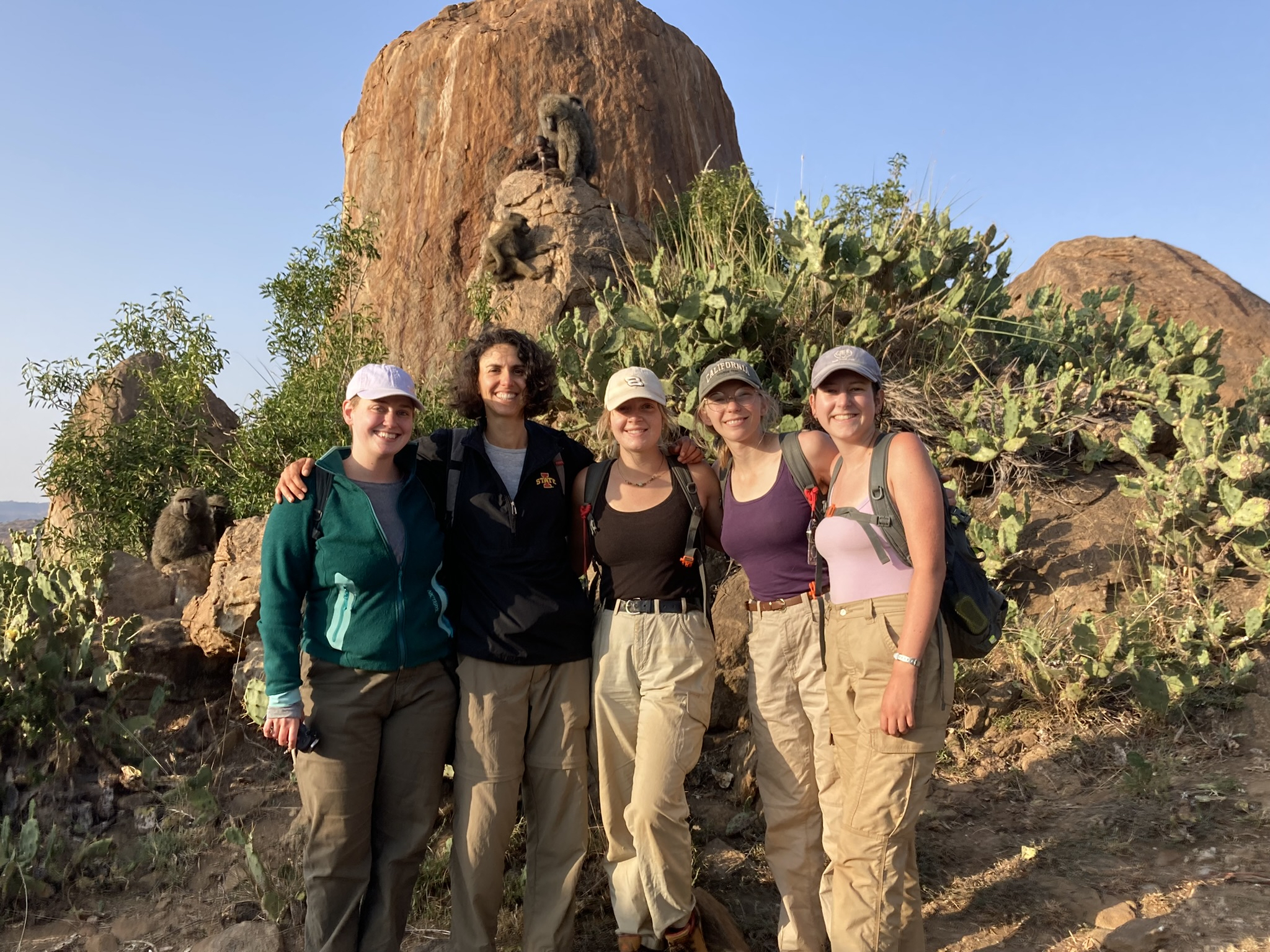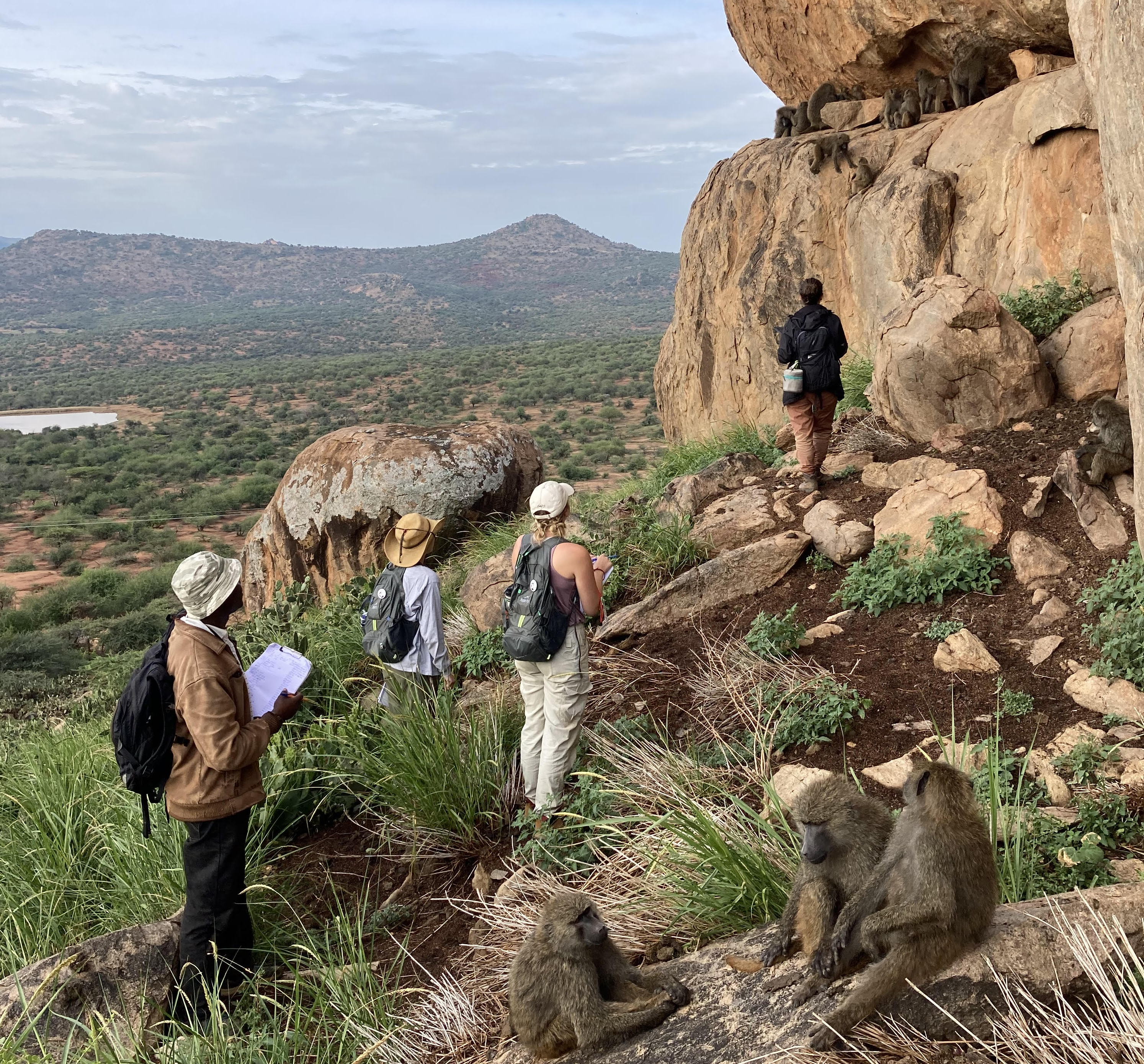
In the summer of 2023, Iowa State graduate Mackenzie Weber (left) and Iowa State student Ella Duster studied baboons at the Uaso Ngiro Baboon Project in Kenya. Photos courtesy of Corinna Most. Larger image.
AMES, Iowa -- For some college students, it would be a tough sell of a summer gig. Shifts start at 6 a.m. with an uphill climb to the job site, where the work is often frustrating and usually sweaty. There’s no running water, spotty internet access and no electricity when the sun goes down. Seeing giraffes on the daily commute is cool. Hearing lions roar at night? Not so much.
But for students interested in a career studying animal behavior, the summer program run by Corinna Most offers a potentially life-changing opportunity.
Most, an adjunct assistant professor of ecology, evolution and organismal biology at Iowa State University, is a primatologist and the co-director of the Uaso Ngiro Baboon Project (UNBP) in Kenya. She’ll lead five students on a trip there next summer to conduct paid field research, which could open doors to graduate school and research careers. Previous participation in immersive, hands-on work is highly valued in the field, but it often requires volunteering or long-term commitments.

Corinna Most, an adjunct assistant professor of ecology, evolution and organismal biology at Iowa State University, with students at the Uaso Ngiro Baboon Project in summer 2023. The group included, from left, graduate student Kale Hawks, Most, and undergraduates Mackenzie Weber, Ella Duster and Bryn Williams. Larger image.
“For many students, it doesn’t work financially or logistically,” Most said. “It’s such a gatekeeping experience.”
A $300,000 grant Most received from the National Science Foundation will help remove those obstacles for four undergraduates and one graduate student per year through 2025. The funding covers all expenses and a $600 per week stipend to study olive baboons for eight weeks at the UNBP. Students work alongside the full-time staff at the site, where researchers have studied several troops of baboons – some larger than 100 members – for nearly 40 years.
Baboon eyes
The UNBP is where Most got her first taste of field work 13 years ago, learning to live in remote cabins a long way from home and to discern one baboon from another – an essential skill that takes time to develop. Being able to identify individual baboons was a defining moment in her career.
“I really think of it as something finally clicking in your brain. Once you can recognize each individual, you start being able to track their social dynamics and patterns, and all of a sudden, you’re a primatologist,” she said.
The group of students Most took to Kenya this past summer, the first of three years funded by the NSF grant, had to persevere to get their “baboon eyes,” too.
“At first, I was like, ‘There’s no way I’m going to learn this.’ It was really empowering to get the hang of it,” said Bryn Williams, a senior in animal ecology from Staples, Minn.
It’s crucial to make out which baboon is which because research is based mostly on observing their behavior, with a focus on interactions such as grooming, mating, fighting and avoidance. While apes such as chimpanzees and bonobos are more genetically similar to humans, baboons live in an environment our earliest ancestors might recognize – on open savannahs in large groups with intense social connections. They’re together at all times, in troops formed around multiple generations of female relatives.
“Baboons are really good evolutionary models for humans,” Most said.
A confidence booster
On site, students select a research project and collect data to support it, scrawling out handwritten notes to later compile digitally. Kale Hawks is a graduate student in ecology and evolutionary biology who has worked on baboon project data in Most’s research group since early 2022. Hawks is interested in how male baboons’ social networks change over time and spent the 2023 trip tracking 15 males about to reach adulthood. The data will be supplemented by historical records from the UNBP.
“I’m amazed by what I was able to accomplish in eight weeks,” said Hawks, who said the project will hopefully serve as the basis of their master’s thesis and eventually a dissertation. The trip was a major confidence-builder that helped convince Hawks a PhD is possible.

Observers at the Uaso Ngiro Baboon Project (UNBP) watch a group of baboons on a cliff. Observers are, from left, senior UNBP observer James King'Au, ISU students Bryn Williams and Mackenzie Weber, and Florence Landry, a doctoral student at the University of Montreal. Larger image.
“I wasn’t even sure I had what it takes to be a researcher, let alone a field researcher traipsing around on the savannahs,” Hawks said. “Now I can picture what a field study should look like and what it takes. Grants are extremely competitive, and this experience gives me an edge.”
Ella Duster, a senior in animal ecology from Solon, said last summer’s trip pushed her out of her comfort zone and helped spark an interest in research and possibly graduate school, neither of which she’d been seriously considering.
“My biggest takeaway is that I can do things that I didn’t think I could do before,” she said.
Students from the 2023 trip presented their research in October at the Midwest Primate Interest Group, a primatology conference in St. Louis. Learning how to turn field notes into professional research is part of the program’s purpose, Most said.
“It’s much more than just those eight weeks in Kenya,” she said.
The confidence gained extended beyond scholarly and scientific capability. It also was enlightening to make connections in Kenya, showing Hawks they can make friends anywhere.
“If I ever do make it back to Kenya, I’ve got people to check on and give a hug. I send them pictures of the leaves turning colors here, and they send me photos of the savannah greening up from the rain,” Hawks said. “There are amazing people all over the world.”
Dec. 1 deadline
Duster, Williams and Hawks all said they would not have been able to spend the summer at Uaso Ngiro if it weren’t for the program funding.
“I absolutely loved it, but there’s definitely no way I would have been able to go without the grant,” Williams said. “I’m so glad it’s for three years so other students have the opportunity.”
Most is taking applications for the summer 2024 program through Dec. 1. Students can apply online.